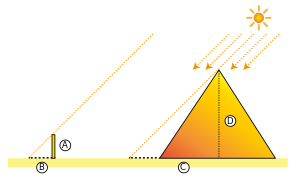Intercept theorem
The intercept theorem, also known as Thales's theorem, basic proportionality theorem or side splitter theorem, is an important theorem in
Formulation of the theorem


Suppose S is the common starting point of two rays and A, B are the intersections of the first ray with the two parallels, such that B is further away from S than A, and similarly C, D are the intersections of the second ray with the two parallels such that D is further away from S than C. In this configuration the following statements hold:[1][2]
- The ratio of any two segments on the first ray equals the ratio of the according segments on the second ray:
, , - The ratio of the two segments on the same ray starting at S equals the ratio of the segments on the parallels:
- The converse of the first statement is true as well, i.e. if the two rays are intercepted by two arbitrary lines and holds then the two intercepting lines are parallel. However, the converse of the second statement is not true (see graphic for a counterexample).
Extensions and conclusions


The first two statements remain true if the two rays get replaced by two lines intersecting in . In this case there are two scenarios with regard to , either it lies between the 2 parallels (X figure) or it does not (V figure). If is not located between the two parallels, the original theorem applies directly. If lies between the two parallels, then a reflection of and at yields V figure with identical measures for which the original theorem now applies.[2] The third statement (converse) however does not remain true for lines.[3][4][5]
If there are more than two rays starting at or more than two lines intersecting at , then each parallel contains more than one line segment and the ratio of two line segments on one parallel equals the ratio of the according line segments on the other parallel. For instance if there's a third ray starting at and intersecting the parallels in and , such that is further away from than , then the following equalities holds:[4]
- ,
For the second equation the converse is true as well, that is if the 3 rays are intercepted by two lines and the ratios of the according line segments on each line are equal, then those 2 lines must be parallel.[4]
Related concepts
Similarity and similar triangles

The intercept theorem is closely related to
Scalar multiplication in vector spaces
In a normed vector space, the axioms concerning the scalar multiplication (in particular and ) ensure that the intercept theorem holds. One has
Applications
Algebraic formulation of compass and ruler constructions
There are three famous problems in elementary geometry which were posed by the Greeks in terms of
- Trisecting the angle
- Doubling the cube
- Squaring the circle
It took more than 2000 years until all three of them were finally shown to be impossible. This was achieved in the 19th century with the help of algebraic methods, that had become available by then. In order to reformulate the three problems in algebraic terms using field extensions, one needs to match field operations with compass and straightedge constructions (see constructible number). In particular it is important to assure that for two given line segments, a new line segment can be constructed, such that its length equals the product of lengths of the other two. Similarly one needs to be able to construct, for a line segment of length , a new line segment of length . The intercept theorem can be used to show that for both cases, that such a construction is possible.
Dividing a line segment in a given ratio
|
To divide an arbitrary line segment in a ratio, draw an arbitrary angle in A with as one leg. On the other leg construct equidistant points, then draw the line through the last point and B and parallel line through the mth point. This parallel line divides in the desired ratio. The graphic to the right shows the partition of a line segment in a ratio.[8] |
 |
Measuring and survey
Height of the Cheops pyramid


According to some historical sources the Greek mathematician
Thales measured the length of the pyramid's base and the height of his pole. Then at the same time of the day he measured the length of the pyramid's shadow and the length of the pole's shadow. This yielded the following data:
- height of the pole (A): 1.63 m
- shadow of the pole (B): 2 m
- length of the pyramid base: 230 m
- shadow of the pyramid: 65 m
From this he computed
Knowing A, B and C he was now able to apply the intercept theorem to compute
Measuring the width of a river
Parallel lines in triangles and trapezoids
The intercept theorem can be used to prove that a certain construction yields parallel line (segment)s.
|
If the midpoints of two triangle sides are connected then the resulting line segment is parallel to the third triangle side (Midpoint theorem of triangles).  |
If the midpoints of the two non-parallel sides of a trapezoid are connected, then the resulting line segment is parallel to the other two sides of the trapezoid.  |
Historical aspects
The theorem is traditionally attributed to the Greek mathematician Thales of Miletus, who may have used some form of the theorem to determine heights of pyramids in Egypt and to compute the distance of ship from the shore.[11][12][13][14]
Proof
An elementary proof of the theorem uses triangles of equal area to derive the basic statements about the ratios (claim 1). The other claims then follow by applying the first claim and contradiction.[1]
Claim 1
Claim 2
 Draw an additional parallel to through A. This parallel intersects in G. Then one has and due to claim 1 and therefore
|
Claim 3
Notes
- ^ ISBN 3-506-99189-2.
- ^ a b Strahlensätze. In: Schülerduden: Mathematik I. Dudenverlag, 8. edition, Mannheim 2008, pp. 431–433 (German)
- )
- ^ ISBN 9783662530344, pp. 191–208 (German)
- ^ See Agricola/Thomas or the following figure:

|SA| / |SB| = |SC| / |SD| does not necessarily imply AC is parallel to BD. - ISBN 0-486-42515-0
- ISBN 3-528-07243-1.
- )
- MacTutor, the (translated) original works of Plutarch and Laertius are: Moralia, The Dinner of the Seven Wise Men, 147A and Lives of Eminent Philosophers, Chapter 1. Thales, para.27)
- ISBN 9783030409746, pp. 214–217
- ISBN 978-3-662-66493-3, pp. 27-36
- ^ Francis Borceux: An Axiomatic Approach to Geometry. Springer, 2013, pp. 10–13
- ISBN 9780521118019, pp. 17-18
- ^ Lothar Redlin, Ngo Viet, Saleem Watson: "Thales' Shadow", Mathematics Magazine, Vol. 73, No. 5 (Dec., 2000), pp. 347-353 (JSTOR
References
- )
- )
- Stillwell, John (2005). The Four Pillars of Geometry. Springer. p. 34. )
- Ostermann, Alexander; Wanner, Gerhard (2012). Geometry by Its History. Springer. pp. 3–7. )
- Lorenz Halbeisen, Norbert Hungerbühler, Juan Läuchli: Mit harmonischen Verhältnissen zu Kegelschnitten: Perlen der klassischen Geometrie. Springer 2016, ISBN 9783662530344, pp. 191–208 (German)
External links
- Intercept Theorem at PlanetMath
- Alexander Bogomolny: Thales' Theorems and in particular Thales' Theorem at Cut-the-Knot
- intercept theorem interactive



































































